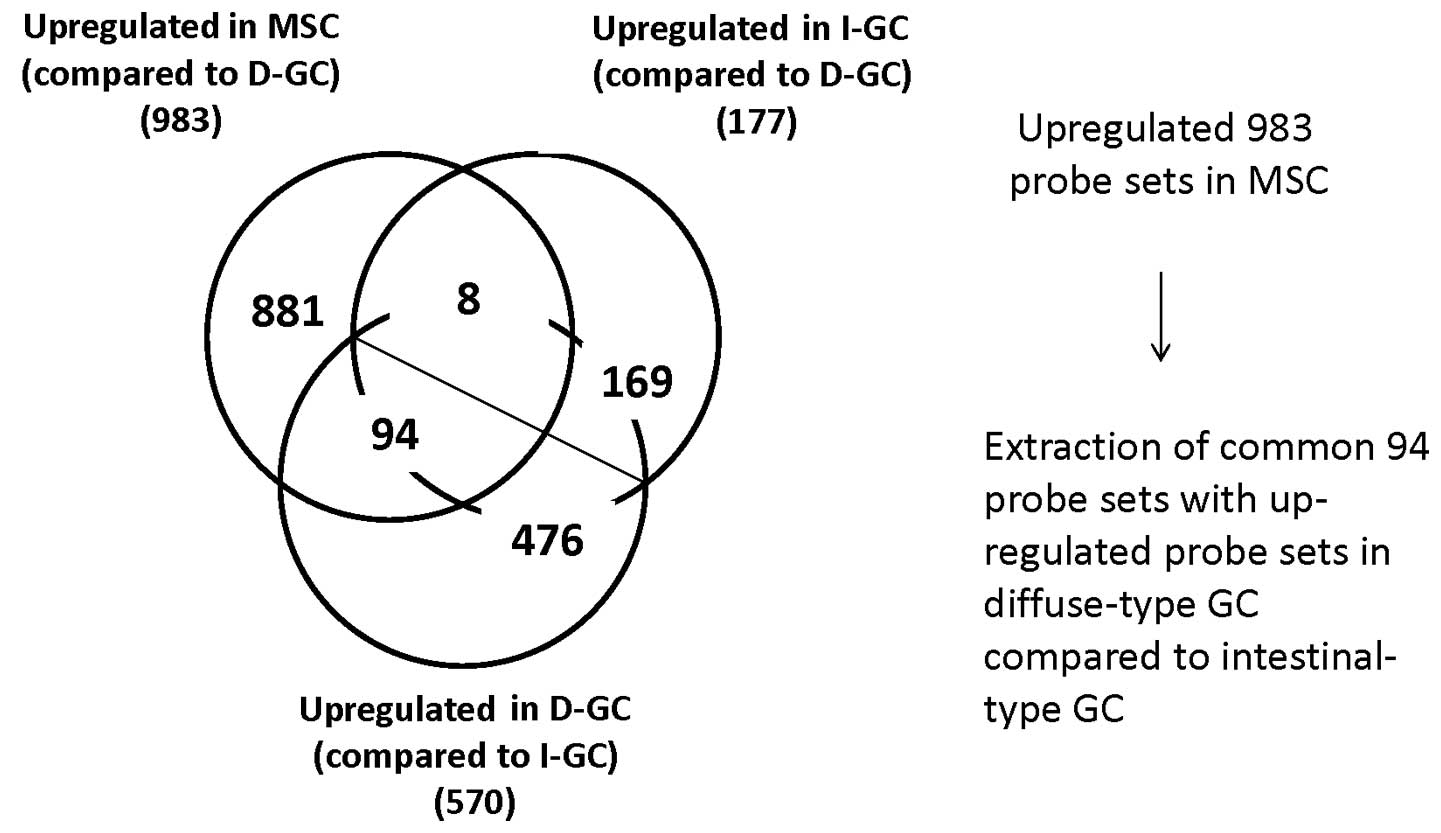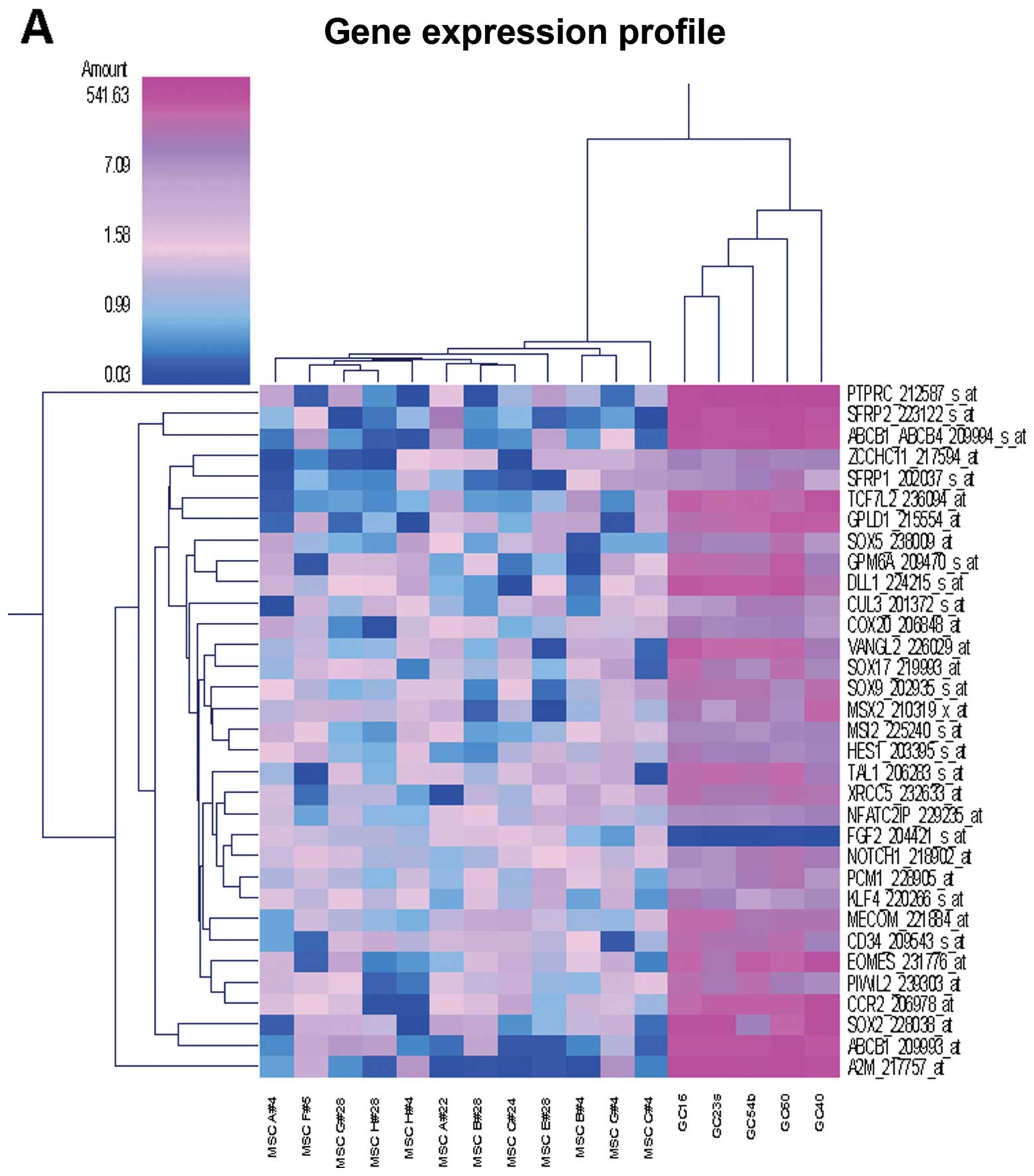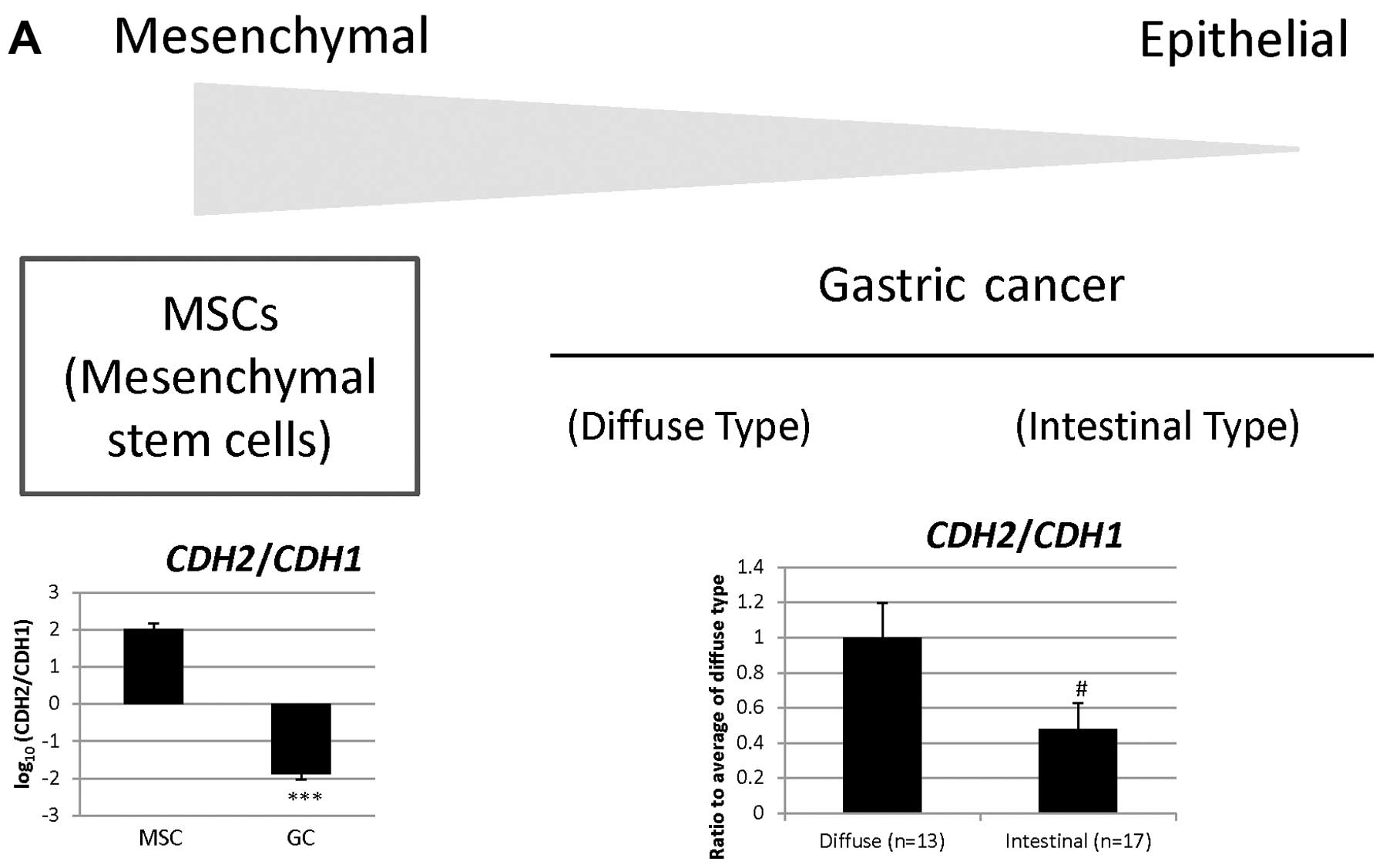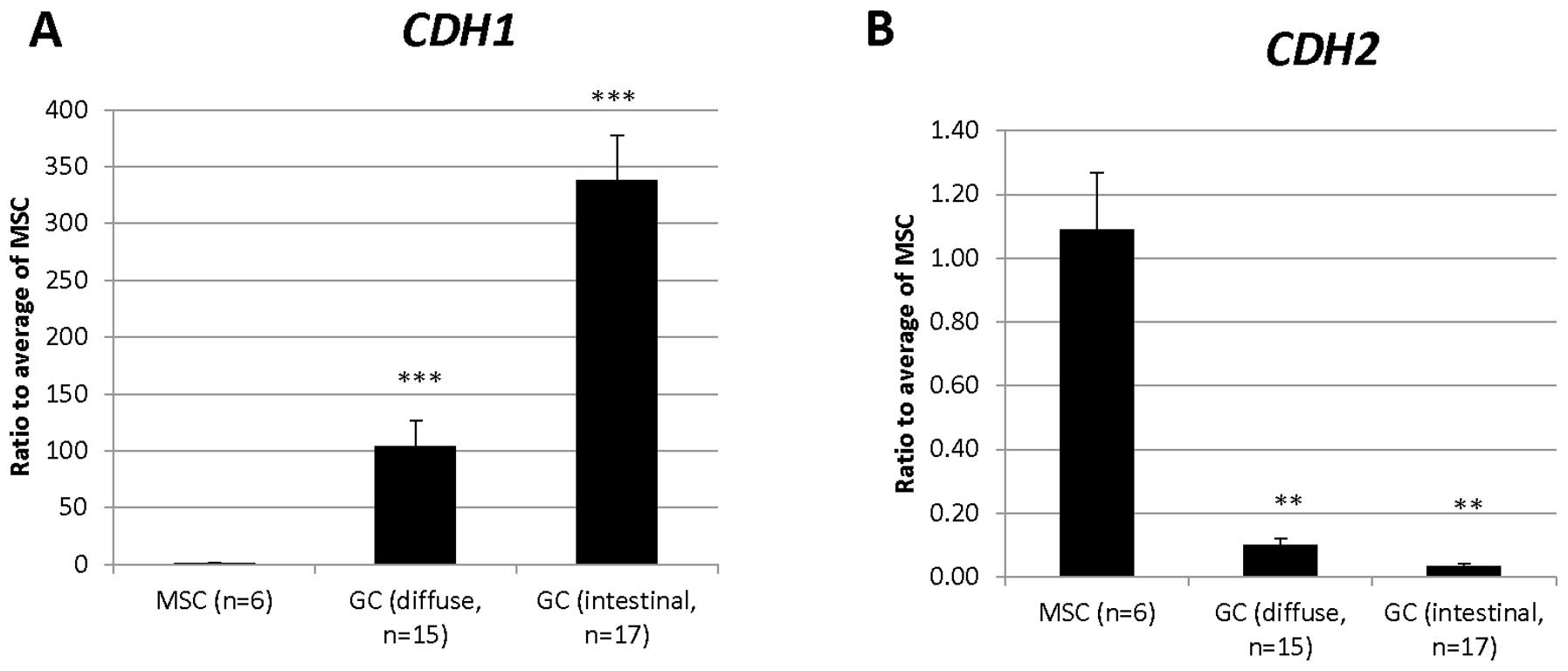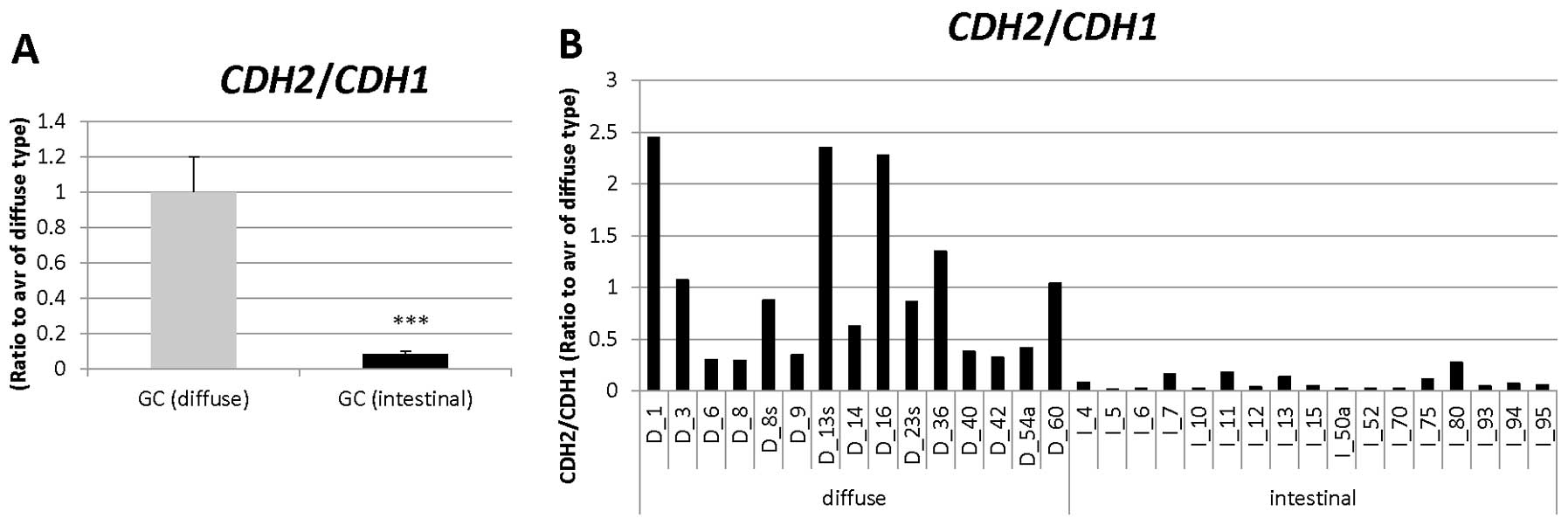Gene expression signatures for identifying diffuse-type gastric cancer associated with epithelial-mesenchymal transition
- Authors:
- Published online on: April 11, 2014 https://doi.org/10.3892/ijo.2014.2387
- Pages: 1955-1970
Abstract
Introduction
Gene expression is dramatically deregulated in tumor development and progression. Various epithelial cell-derived cancers often have mesenchymal features. Epithelial-mesenchymal transition (EMT) is a physiological phenotypic shift in which epithelial cells with cell-cell and cell-extracellular matrix connections transform into mesenchymal cells and then migrate to other locations within the body (1). EMT is a key developmental process that is often activated during cancer invasion and metastasis, and EMT in immortalized human mammary epithelial cells results in the development of mesenchymal cells and the expression of stem-cell markers (2). These insights highlight the need to investigate the relationship between cancer and mesenchymal cells. Cancer genomic landscapes have been revealed, and mutations in cancer-associated genes involved in cell proliferation have been discovered (3). Here, we report that the expression of several genes involved in EMT or stem cell development is altered in cancer cells and mesenchymal stem cells (MSCs).
Gastric cancer (GC) is one of the leading causes of cancer-related deaths worldwide. Histopathologically, GC can be divided into two major categories: intestinal-type and diffuse-type. Intestinal-type GC develops via sequential stages including Helicobacter pylori (H. pylori)-associated gastritis, intestinal metaplasia (IM) and dysplasia. This type is found predominantly in high-risk geographic areas, such as East Asia, and is strongly correlated with the prevalence of H. pylori infection among the elderly. In contrast, diffuse-type GC appears in half of all GC cases and is more geographically dispersed. Diffuse-type GC typically develops from H. pylori-free, morphologically normal gastric mucosa without atrophic gastritis, or IM, and is both genetically and phenotypically different from intestinal-type GC (4-8). Unlike the decreasing incidence of intestinal-type GC, the prevalence of diffuse-type GC is reportedly increasing worldwide. Therefore, the molecular characterization of diffuse-type GC, with a particular focus on its infiltrating and scattered growth, is important for the development of novel therapeutics for this disease. The infiltrating and scattered growth of diffuse-type GC has been reported to be mediated by the loss of E-cadherin [cadherin 1, type 1, E-cadherin (epithelial) (CDH1)] function through somatic mutation, promoter methylation and cancer-associated down-regulation (9). We previously reported that the activation of hedgehog (Hh) signaling selectively occurs in diffuse-type GC and that blocking the Hh signal inhibits the growth of GC cells in which Hh has been activated (6). We also reported that the EMT regulator ZEB1/SIP1 is a target of Hh signaling in diffuse-type GC and that ZEB1 regulates mesenchymal-related genes WNT5A, CDH2 [cadherin 2, type 1, N-cadherin (neuronal)], PDGFRB, EDNRA, ROBO1, ROR2 (receptor tyrosine kinase-like orphan receptor 2) and MEF2C that are preferentially expressed in diffuse-type GC (7). Thus, the hedgehog-EMT pathway is preferentially activated in diffuse-type GC compared with intestinal-type GC; however, histological typing is currently the only method to distinguish the two major types. Here, we report that diffuse-type GC that has undergone extensive EMT, which has a poor prognosis, was distinguished from intestinal-type GC by quantitative real-time RT-PCR analysis of only two genes.
Materials and methods
Cell culture
Human MSCs from bone marrow (Lonza, Walkersville, MD, USA) were cultured in mesenchymal stem cell growth medium (MSCGM; Lonza #PT-3001; MSC basal medium supplemented with mesenchymal cell growth supplement, L-glutamine, and penicillin/streptomycin) at 37˚C in a 5% CO2 incubator. The cells were passaged according to the manufacturer’s protocol, with a slight modification in the use of trypsin-EDTA solution (Lonza #CC-3232). The following lot numbers of human MSC batches were utilized: #4F1127, #4F0312, #5F0138, #4F1560, #4F0591 and #4F0760. Informed consent was obtained for the development of the Poietics human mesenchymal stem cell systems (Lonza) (10).
Total RNA purification and extraction
The MSCs were cultured on a 10-cm dish, lysed in 600 μl of buffer RLT (RNeasy lysis buffer) with β-mercaptoethanol, and homogenized using a QIA shredder (Qiagen, Düsseldorf, Germany). Total RNA was purified using RNeasy mini spin columns according to the manufacturer’s protocol (Qiagen). Total RNA was eluted with RNase-free water (10). Cancer samples were lysed with Isogen lysis buffer and total RNA was extracted by precipitation with isopropanol (11).
Microarray analysis
Total RNA (100 ng) was reverse transcribed and amplified using a GeneChip kit (Affymetrix, Santa Clara, CA, USA). The microarray analysis was performed using GeneChip Human Genome U95Av2 or U133 Plus2.0 (Affymetrix) in accordance with the manufacturer’s instructions (10,11). Human bone marrow-derived MSCs are commercially available from Lonza, and gastric cancer cells were obtained from the National Cancer Center Research Institute. The microarray data on human MSCs and gastric cancer are available to the public in NCBI’s Gene Expression Omnibus (GEO) database and are accessible via GEO Series accession number GSE7888 and GSE42252, respectively (10,12).
Quantitative real-time RT-PCR analysis
Real-time RT-PCR was performed using primer sets designed for detecting CDH1 (5′-GGGGTAGTGAGGATCTTGAT-3′ and 5′-TCCTTTTCC ACCCCCAAAGA-3′), CDH2 (5′-GGCATAGTCTATGGA GAAGT-3′ and 5′-GCTGTTGTCAGAAGTCTCTC-3′) and VIM (5′-GCTTTCAAGTGCCTTTCTGC-3′ and 5′-GTT GGTTGGATACTTGCTGG-3′). Quantitative real-time PCR was performed using a Bio-Rad iCycler with iQ SYBR-Green Super mix as previously reported (11). The relative mRNA expression level of each gene was normalized to that of ACTB (β-actin: 5′-GAAGTCCCTTGCCATCCTAA-3′ and 5′-GCA CGAAGGCTCATCATTCA-3′) using the ΔΔCt method.
Statistics
Student’s t-test or Wilcoxon’s U test was performed to calculate the P-values. Microsoft Excel and GeneSpring software (Agilent Technologies, Ltd., CA, USA) were used for the analyses.
Results
Comparing the expression of EMT-related genes in MSCs and diffuse-type GC
The microarray gene expression analysis identified 51 upregulated probe sets that had detectable cells in either all of the 12 MSC samples or all of the 5 diffuse-type GC samples; the average GAPDH-normalized signal intensity of these upregulated probe sets in MSCs was >10-fold higher than the average GAPDH-normalized signal intensity in diffuse-type GC (P<0.0001) (Tables I and II). This class of probe sets contained probes recognizing CDH2, which encodes N-cadherin, a protein that has been reported to be involved in EMT (13). CDH2 was upregulated in 12 MSC samples compared with the 5 diffuse-type GC samples (Fig. 1A). A previous report demonstrated that CDH2 is a marker of EMT (13). E-cadherin stabilizes cellular organization or conformation (14). The expression of CDH1 (E-cadherin), which plays an important role in the cell junctions of epithelial cells, was downregulated in MSCs compared with diffuse-type GC (Fig. 1B). It has been reported that HMLER cancer cells (human mammary epithelial cells transformed with genomic versions of SV40 large-T, hTERT and H-rasV12) have an increased CD44high/CD24low cancer stem cell (CSC) fraction after treatment with small interfering RNA targeting CDH1 (15,16). This report details the involvement of CDH1 in interfering with the CSC phenotype and in inducing stem cell differentiation. Considering the expression patterns of CDH2 and CDH1 in MSCs and diffuse-type GC, most of the cells in diffuse-type GC are likely to have an epithelial-like phenotype, although there is more evidence of EMT in diffuse-type GC than in intestinal-type GC.
We further examined mesenchymal phenotype-related genes in 5 diffuse-type GC samples and identified 1461 upregul ated probe sets with an average signal intensity >500 in the 12 MSC samples and with greater than a 2-fold change in the 12 MSC samples compared with the 5 diffuse-type GC samples using the U133Plus2.0 platform. Of these 1461 probe sets, 983 were aligned with the U95Av2 platform. Using the U95Av2 platform, 94 probe sets were determined to be upregulated in the 13 diffuse-type GC samples compared with the 17 intestinal-type GC samples (Fig. 2). Probe sets that recognized the same symbol were unified in probe sets with a larger fold-change and 77 genes were selected (Table III). FN1 (fibronectin 1) was upregulated in MSCs compared with diffuse-type GC (Fig. 3A). It has been reported that salinomycin has selective toxicity in the stem cells of epithelial cell-derived cancers and that it induces epithelial cell differentiation (17). Salinomycin, a selective breast cancer stem cell inhibitor, has been reported to decrease stem cell-related genes such as CCND1 (cyclin D1), LEF1 and FN1, which are targets of Wnt signaling (17). The role of Wnt signaling in different cell types may be an interesting target for cancer stem cell machinery (18,19). Gene expression was analyzed to investigate whether these stem cell-related genes were involved in the cellular phenotypic changes. FN1 was upregulated in MSCs compared with diffuse-type GC, suggesting that the stem cell phenotype was more typical in MSCs than in diffuse-type GC (Fig. 3A). One of the probe sets recognizing VIM (vimentin) was upregulated in diffuse-type GC compared with MSCs (Fig. 3B).
Table III.Common genes among the upregulated probe sets in MSCs compared with diffuse-type GC (U133Plus2.0) and the upregulated probe sets in diffuse-type GC compared with intestinal-type GC (U95Av2). |
Comparing the expression of stem cell-related genes in MSCs and diffuse-type GC
To identify markers of EMT or the stemness phenotype of diffuse-type GC, we compared the expression of stem cell-related genes in MSCs and diffuse-type GC. We first selected stem-cell related genes based on biological processes using gene ontology and then performed a clustering analysis of the signal intensity of 33 stem cell-related genes that had greater than a 5-fold change in the GAPDH-normalized signal intensity in GC compared with MSCs (NCSS2007) (Fig. 4A). Among these 33 stem cell-related genes, 10 were selected that were significantly differentially expressed (more than a 20-fold change; P<0.01 and P<0.05; n=12 MSCs and n=5 diffuse-type GCs) (Fig. 4B). SOX2, which is involved in embryonic and adult tissue stem cell maintenance, was upregulated in diffuse-type GC compared with MSCs. This corresponded with previous reports indicating that SOX2 was overexpressed or mutated in a stage-dependent manner in certain types of cancer (20–22). NOTCH1, which plays a well-known role in cancer development and EMT, was also upregulated in diffuse-type GC compared with MSCs. ID3 was downregulated in diffuse-type GC compared with MSCs. NANOG (Nanog homeobox), which is involved in maintaining the pluripotency of embryonic stem cells, was upregulated in diffuse-type GC compared with MSCs (Fig. 4C). NANOG functions in conjunction with ten-eleven translocation (TET) family proteins, and TET1 enhances the efficacy of reprogramming (23). TET1 was also upregulated in diffuse-type GC compared with MSCs.
These data indicating that embryonic stem cell-related genes may play a role in cancer cells in which EMT occurs, such as in diffuse-type GC rather than in MSCs, are very interesting; however, if particular EMT markers are overexpressed in MSCs, then these genes are unlikely to be useful for distinguishing diffuse-type GC from intestinal-type GC.
The mRNA ratio of CDH2 to CDH1 distinguished the mesenchymal from the epithelial phenotype
Using the microarray results, the mRNA ratios of CDH2 to CDH1 were compared in 12 MSC samples and 5 diffuse-type GC samples, and in 13 diffuse-type GC samples and 17 intestinal-type GC samples. The results and a diagram showing the phenotypic transition among the samples are shown in Fig. 5A. The mRNA ratio of CDH2/CDH1 was higher in MSCs than in diffuse-type GC. The mRNA ratio of CDH2/CDH1 was also higher in diffuse-type GC samples than in intestinal-type GC samples. The combin ation of the CDH2 and CDH1 mRNA levels may distinguish the mesenchymal cell phenotype from the epithelial cell phenotype. WNT5A upregulation has been reported to be associated with EMT (7). The WNT5A/WNT4 ratio was higher in MSCs than in diffuse-type GC, whereas the WNT5A/WNT4 ratio was similar in the diffuse- and intestinal-type GCs (Fig. 5B). Accordingly, the combination of WNT5A and WNT4 may only distinguish MSCs from GC.
We performed quantitative real-time RT-PCR to detect the expression of CDH1 and CDH2 in 6 MSC samples, 15 diffuse-type GC samples and 17 intestinal-type GC samples. In accordance with the above microarray results, CDH1 was upregulated and CDH2 was downregulated in GC compared with MSCs (Fig. 6). The CDH2/CDH1 mRNA ratio was confirmed to be higher in MSCs than in both types of GC. Most importantly, the CDH2/CDH1 mRNA ratio was perfect at distinguishing the 15 diffuse-type GC samples from the 17 intestinal-type GC samples (Fig. 7); all of the 15 diffuse-type GC samples had ratios that were higher than the intestinal-type GC sample with the highest ratio (I-80).
VIM is one of the most validated EMT markers. Therefore, using quantitative real-time RT-PCR, we investigated the possibility that the combination of VIM and CDH1 could distinguish the mesenchymal phenotype from the epithelial phenotype (Fig. 8). The VIM/CDH1 mRNA ratio was higher in MSCs than in both types of GC. However, the VIM/CDH1 ratio was much more varied among the 32 GC samples than the CDH2/CDH1 ratio. As mentioned above, there was a threshold CDH2/CDH1 ratio that distinguished the 15 diffuse-type GC samples from the 17 intestinal-type GC samples, whereas some intestinal-type GC samples (for example, I-11 and I-15) had a higher VIM/CDH1 ratio than certain diffuse-type GC samples.
Discussion
We previously compared the expression profiles of 18 intestinal-type GC and 12 diffuse-type GC samples with typical characteristics in terms of cell growth (clustered or scattered) and differentiation (well/moderate or poor), and selected genes based on their expression levels in the two types of cancer (7). A gene was selected using the Wilcoxon U test (P<0.05) from genes with more than a 2-fold change on average. By this procedure, a total of 892 genes were identified (704 genes specific to diffuse-type and 188 genes specific to intestinal-type). The two types of GC were completely separated by two-dimensional hierarchical clustering analysis of the 892 selected genes. In this paper, we reported that an EMT regulator, ZEB1/SIP1, is a target of the primary transcription factor GLI1 in the Hh signaling pathway in diffuse-type GC and that ZEB1/SIP1 further activates NOTCH2 and other EMT regulators [snail family zinc finger 2 (SNAI2) and twist family bHLH transcription factor 2 (TWIST2)]. SNAI2 upregulates CDH2 and WNT5A and downregulates CDH1. TWIST2 upregulates CDH2, ROR2, which is the WNT5A receptor, and other mesenchymal-related genes (PDGFRB, EDNRA, ROBO1 and MEF2C). Accordingly, we concluded that Hh signaling-mediated EMT specifically occurred in diffuse-type GC. This crosstalk between Hh signaling and EMT has been reported in esophageal squamous cell carcinoma (24). However, we were unable to identify a single marker that distinguished the 12 diffuse-type GC samples from the 18 intestinal-type GC samples. Therefore, herein, we searched for such genes by comparing the expression profiles of diffuse-type GC and MSCs, which are typical mesenchymal cells. Among the 1461 probe sets that were significantly upregulated in MSCs, we selected 94 probes (77 genes) that were upregulated in diffuse-type GC compared with intestinal-type GC (Table III).
The typical mesenchymal cell markers FN1, VIM and CDH2 were highly expressed in MSCs. Regarding EMT regulators, it is known that the Snail family transcription factor regulates EMT by repressing CDH1 gene transcription (25). SNAI2 expression was higher in MSCs than in diffuse-type GC. CDH1 gene regulation might be involved in EMT because it was shown that intracellular CDH1 is located at the membrane after treatment with siRNA targeting the EMT regulator ZEB2/SIP1 in esophageal cancer (24). In terms of Wnt signaling, WNT5A was upregulated in MSCs compared with diffuse-type GC; however, its receptor ROR2 was more highly expressed in diffuse-type GC than in MSCs. Regarding Notch signaling, NOTCH1, 3 and 4 were highly expressed in the diffuse-type GC samples, whereas NOTCH2 was upregulated in MSCs. Because NOTCH is related to stem cell maintenance, this alteration in gene expression may reflect transitions or modifications in stem cell features (26). In terms of other stem cell markers, a recent report suggested that Lgr5+ cells in mouse intestinal adenomas acquired the ability for cancerous growth as a stem cell (27). Dclk1 (doublecortin-like kinase 1), which is a candidate marker for intestinal cancer stem cells, did not dramatically differ in expression between diffuse-type GC and MSCs (28).
From these results, we selected FN1, VIM, CDH2, SNAI2, WNT5A and NOTCH2 as EMT-related genes that were upregulated in MSCs. However, all 6 of these genes were included in our previously-selected 704 genes that were upregulated in diffuse-type GC compared with intestinal-type GC. Therefore, we examined the power of the mRNA ratio of each of these 6 mesenchymal-related genes to a typical epithelial marker gene, CDH1. We determined that the mRNA ratio of CDH2 to CDH1 has great potential as a single indicator that distinguishes diffuse-type GC from intestinal-type GC. In the near future, the power of this simple indicator of EMT should be evaluated in a large cohort study of GC as well as other tumor types.
Acknowledgements
We gratefully acknowledge Dr Ryoji Kushima for the pathological and clinical evaluations. We would also like to thank Ms. Rie Komatsuzaki and Ms. Fumiko Chiwaki for their technical assistance. This study was supported in part by the National Institute of Biomedical Innovation (for the Advanced Research for Medical Products Mining Programme ID10-41, ID12-01), the Ministry of Health, Labour and Welfare of Japan (for the Third Comprehensive 10-Year Strategy for Cancer Control H22-007 and for Cancer Control and Cancer Research 20-12), National Cancer Center Research and Development Fund (23-A-7, 23-B-6, 23-B-18, 25-A-6), the Ministry of Education, Culture, Sports, Science and Technology of Japan (23501322) and the Princess Takamatsu Cancer Research Fund.
References
|
Radisky DC and LaBarge MA: Epithelial-mesenchymal transition and the stem cell phenotype. Cell Stem Cell. 2:511–512. 2008. View Article : Google Scholar : PubMed/NCBI | |
|
Mani SA, Guo W, Liao MJ, et al: The epithelial-mesenchymal transition generates cells with properties of stem cells. Cell. 133:704–715. 2008. View Article : Google Scholar : PubMed/NCBI | |
|
Vogelstein B, Papadopoulos N, Velculescu VE, et al: Cancer genome landscapes. Science. 339:1546–1558. 2013. View Article : Google Scholar : PubMed/NCBI | |
|
Saeki N, Saito A, Choi IJ, et al: A functional single nucleotide polymorphism in mucin 1, at chromosome 1q22, determines susceptibility to diffuse-type gastric cancer. Gastroenterology. 140:892–902. 2011. View Article : Google Scholar : PubMed/NCBI | |
|
Sakamoto H, Yoshimura K, Saeki N, et al: Genetic variation in PSCA is associated with susceptibility to diffuse-type gastric cancer. Nat Genet. 40:730–740. 2008. View Article : Google Scholar : PubMed/NCBI | |
|
Fukaya M, Isohata N, Ohta H, et al: Hedgehog signal activ ation in gastric pit cell and in diffuse-type gastric cancer. Gastroenterology. 131:14–29. 2006. View Article : Google Scholar | |
|
Ohta H, Aoyagi K, Fukaya M, et al: Cross talk between hedgehog and epithelial-mesenchymal transition pathways in gastric pit cells and in diffuse-type gastric cancers. Br J Cancer. 100:389–398. 2009. View Article : Google Scholar | |
|
Ueda T, Volinia S, Okumura H, et al: Relation between microRNA expression and progression and prognosis of gastric cancer: a microRNA expression analysis. Lancet Oncol. 11:136–146. 2010. View Article : Google Scholar : PubMed/NCBI | |
|
Kountouras J, Zavos C and Chatzopoulos D: New concepts of molecular biology on gastric carcinogenesis. Hepatogastroenterology. 52:1305–1312. 2005.PubMed/NCBI | |
|
Tanabe S, Sato Y, Suzuki T, et al: Gene expression profiling of human mesenchymal stem cells for identification of novel markers in early- and late-stage cell culture. J Biochem. 144:399–408. 2008. View Article : Google Scholar : PubMed/NCBI | |
|
Aoyagi K, Minashi K, Igaki H, et al: Artificially induced epithelial-mesenchymal transition in surgical subjects: its implications in clinical and basic cancer research. PLoS One. 6:e181962011. View Article : Google Scholar : PubMed/NCBI | |
|
Edgar R, Domrachev M and Lash AE: Gene Expression Omnibus: NCBI gene expression and hybridization array data repository. Nucleic Acids Res. 30:207–210. 2002. View Article : Google Scholar : PubMed/NCBI | |
|
Sigurdsson V, Hilmarsdottir B, Sigmundsdottir H, et al: Endothelial induced EMT in breast epithelial cells with stem cell properties. PLoS One. 6:e238332011. View Article : Google Scholar : PubMed/NCBI | |
|
Guillot C and Lecuit T: Mechanics of epithelial tissue homeostasis and morphogenesis. Science. 340:1185–1189. 2013. View Article : Google Scholar : PubMed/NCBI | |
|
Gupta PB, Onder TT, Jiang G, et al: Identification of selective inhibitors of cancer stem cells by high-throughput screening. Cell. 138:645–659. 2009. View Article : Google Scholar : PubMed/NCBI | |
|
Elenbaas B, Spirio L, Koemer F, et al: Human breast cancer cells generated by oncogenic transformation of primary mammary epithelial cells. Gene Dev. 15:50–65. 2001. View Article : Google Scholar : PubMed/NCBI | |
|
Lu D, Choi MY, Yu J, et al: Salinomycin inhibits Wnt signaling and selectivity induces apoptosis in chronic lymphocytic leukemia cells. Proc Natl Acad Sci USA. 108:13253–13257. 2011. View Article : Google Scholar : PubMed/NCBI | |
|
Huch M, Dorrell C, Boj SF, et al: In vitro expansion of single Lgr5+ liver stem cells induced by Wnt-driven regeneration. Nature. 494:247–250. 2013. View Article : Google Scholar | |
|
Nishimura K, Semba S, Aoyagi K, et al: Mesenchymal stem cells provide an advantageous tumor microenvironment for the restoration of cancer stem cells. Pathobiology. 79:290–306. 2012. View Article : Google Scholar : PubMed/NCBI | |
|
Rudin CM, Durinck S, Stawiski EW, et al: Comprehensive genomic analysis identifies SOX2 as a frequently amplified gene in small-cell lung cancer. Nat Genet. 44:1111–1116. 2012. View Article : Google Scholar : PubMed/NCBI | |
|
Jia X, Li X, Xu Y, et al: SOX2 promotes tumorigenesis and increases the anti-apoptotic property of human prostate cancer cell. J Mol Cell Biol. 3:230–238. 2011. View Article : Google Scholar : PubMed/NCBI | |
|
Bass AJ, Watanabe H, Mermel CH, et al: SOX2 is an amplified lineage-survival oncogene in lung and esophageal squamous cell carcinomas. Nat Genet. 41:1238–1242. 2009. View Article : Google Scholar : PubMed/NCBI | |
|
Costa Y, Ding J, Theunissen TW, et al: NANOG-dependent function of TET1 and TET2 in establishment of pluripotency. Nature. 495:370–374. 2013. View Article : Google Scholar : PubMed/NCBI | |
|
Isohata N, Aoyagi K, Mabuchi T, et al: Hedgehog and epithelialmesenchymal transition signaling in normal and malignant epithelial cells of the esophagus. Int J Cancer. 125:1212–1221. 2009. View Article : Google Scholar : PubMed/NCBI | |
|
Cano A, Pérez-Moreno MA, Rodrigo I, et al: The transcription factor snail controls epithelial-mesenchymal transitions by repressing E-cadherin expression. Nat Cell Biol. 2:76–83. 2000. View Article : Google Scholar : PubMed/NCBI | |
|
Sato T and Clevers H: Growing self-organizing mini-guts from a single intestinal stem cell: mechanism and applications. Science. 340:1190–1194. 2013. View Article : Google Scholar : PubMed/NCBI | |
|
Schepers AG, Snippert HJ, Stange DE, et al: Lineage tracing reveals Lgr5+ stem cell activity in mouse intestinal adenomas. Science. 337:730–735. 2012. View Article : Google Scholar : PubMed/NCBI | |
|
Nakanishi Y, Seno H, Fukuoka A, et al: Dclk1 distinguishes between tumor and normal stem cells in the intestine. Nat Genet. 45:98–103. 2013. View Article : Google Scholar : PubMed/NCBI |




